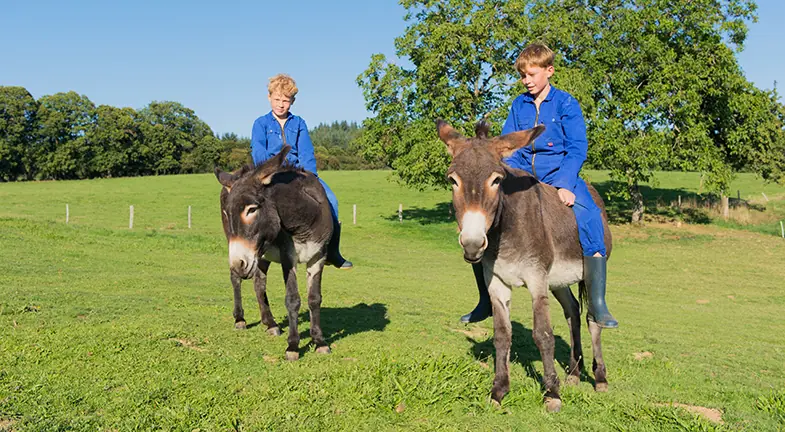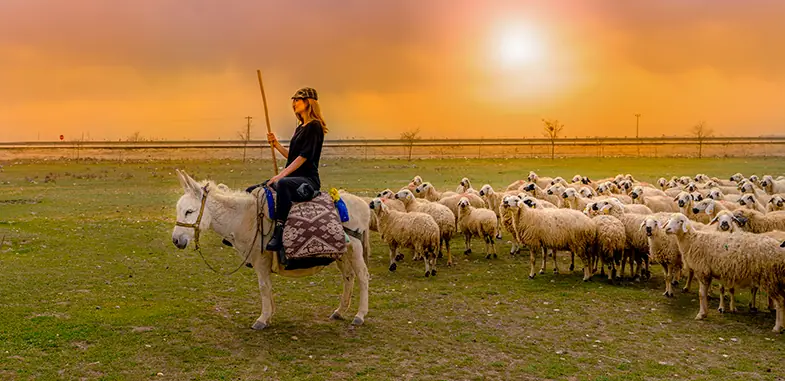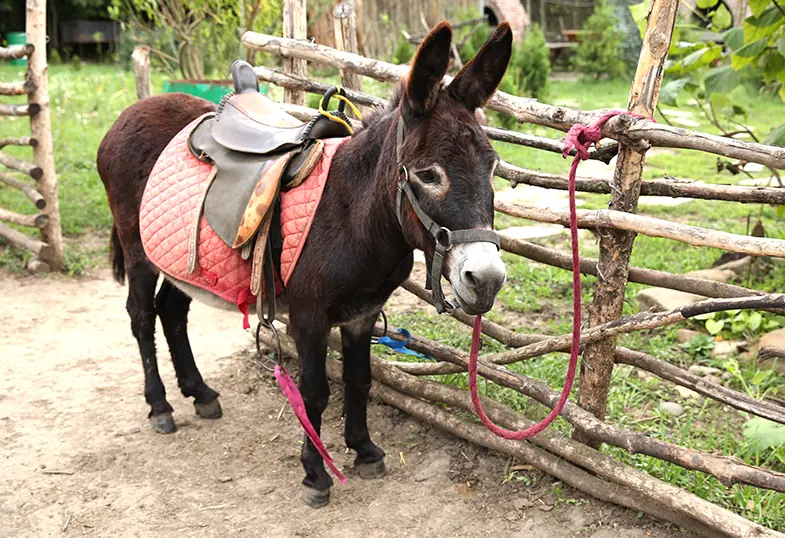I’ve owned donkeys for many years but hadn’t thought about riding them until the other day when I was asked if they could carry a fully grown adult. I have to confess that this is something I’d never considered before so decided to look into whether or not adults are able to ride donkeys and was surprised by what I found.
Can you ride a donkey? It’s perfectly okay to ride a donkey as long as you’re the right size for them. As a rule of thumb, donkeys can carry between 20% and 30% of their body weight so while most donkeys can happily carry children only bigger donkeys are capable of carrying adults.
Traditionally donkeys have been kept as pets, for guarding livestock, or for breeding mules and we haven’t really given too much thought as to whether or not we can ride them but that doesn’t mean we can’t. Donkeys are very strong animals that can be ridden but there are a few things you need to consider before riding them. After all, if you jump on the nearest donkey you find and expect it to be able to ride it you may well be in for a painful lesson.
Can adults ride donkeys as well as children?
Donkeys come in a range of sizes that are classed as types (rather than breeds) but while they’re very strong at pulling loads they’re not able to carry the same amount of weight that they can pull although that doesn’t mean to say they can’t be ridden by children and adults.
There will always be exceptions to every rule but as a guide donkeys can carry between 20% to 30% of their total weight, although this will include all of the tack as well as the rider and any accessories. If we say the average donkey’s weight is approximately 350kg (771.6lbs), and use the 20% rule, this means that they can carry around 70kg (154lbs / 11st) which would mean they can easily carry most children as well as lightweight adults.
This doesn’t mean that you have to be under 70kg to ride a donkey though because donkeys come in three different sizes. While miniature donkeys are only really suitable for very small children and toddlers standard donkeys can happily carry children and some adults. Mammoth donkeys, on the other hand, can very easily carry an average-sized adult. The table below shows the weight limits for different donkey sizes.
| Type of donkey | Weight range of adult donkey | Height range of adult donkey | Maximum weight range a donkey can carry |
|---|---|---|---|
| Miniature | 200lbs – 400lbs 91kg – 181kg | 6.1hh – 9hh 25in – 36in | 40lbs – 80lbs 18kg – 36kg 2.8st – 5.6st |
| Standard | 400lbs – 900lbs 181kg – 408kg | 9hh – 14hh 36in – 56in | 80lbs – 180lbs 36kg – 82kg 5.6st – 12.9st |
| Mammoth | 900lbs – 1300lbs 408kg – 590kg | Over 14.2hh Over 58in | 180lbs – 260lbs 82kg – 117kg 12.9st – 18.4st |
Do donkeys like being ridden?
While it might seem odd to ride a donkey and you might worry that it’s not normal most donkeys, as long as they’ve been properly trained and you respect them, don’t mind being ridden. That doesn’t mean to say that they enjoy it in the same way horses do (or that we do), but if you’re not overloading them and don’t yell at them or force them to do anything they don’t mind being ridden.
Just because donkeys are okay with being ridden it doesn’t mean they always will be happy to be ridden. Unlike horses, donkeys don’t make a fuss when something is wrong but instead will suffer in silence. They’ll continue with what they’re doing even if they’re in pain or suffering in some way so it’s important to learn their language and understand when they’re telling you they don’t want to be ridden or when something is wrong.
At what age can donkeys be ridden?
Many people think that donkeys are just like horses and can be ridden at a young age but this isn’t the case. While they do both belong to the same Equus family they aren’t the same species at all which means that, while they do share many similarities, they are also very different and mature at different rates.
Donkeys can live for up to 55 years (compared to 30 years for horses) so it stands to reason that they’ll take longer to mature and therefore have to be older before they can be ridden. While you can start to train a donkey (without a rider) at around 4 years of age it’s important you wait for the donkey to fully mature, both mentally and physically. With this in mind, you shouldn’t start riding a donkey until they’re around the age of 5 or 6.
Which donkeys are better for riding? Jacks, Jennys or geldings
You might think that a donkey is a donkey is a donkey but when it comes to riding them this isn’t always the case. Of course, you can ride any donkey but if you’re looking for a sensible donkey that’s easy to handle, kind, and perfect for children (and most adults) then a gelding (a male donkey that has been castrated) is by far the best option. They’re the most willing and gentle of all donkeys.
Jennys (female adult donkeys) are very good too but when they’re in season they can be a bit difficult for small children to handle. On the other end of the spectrum, Jacks (adult intact male donkeys) should be avoided by all but the most experienced of riders. They’re often too independent to be ridden and are generally considered too wild.
Things you need to consider before riding a donkey
If you’ve got a donkey and are thinking about riding it then it’s important to know you can’t just put a saddle on them and go for a ride. Firstly you’ll need to make sure your donkey can carry you (the table above will help with that) but you’ll also have to make sure they’re fit enough. If your donkey gets out of breath quickly then make sure you get them into shape beforehand. You should also make sure your donkey’s hooves are in good condition if you don’t and their hooves are in a poor condition it’ll cause them a lot of pain.
As well as making sure the donkey is okay to be ridden you should also make sure you have a good seat and are well balanced. Donkeys normally have very good balance but they find it harder to adjust their balance while the rider is moving around a lot.
Are donkeys safer to ride than horses?
You might be surprised to know that donkeys are generally safer to ride than horses because they’re less spooky. While a lot of horses will run a mile at the first sight of something strange or loud noises donkeys will do the opposite. They’re more likely to freeze and assess the situation for themselves before deciding it’s safe to proceed, this is one of the reasons why people wrongly think donkeys are stubborn.
Donkeys are also a lot smarter than horses and aren’t prone to moments of madness. This, combined with their gentle natures means they’re ideal for young children, especially those that are nervous around horses.
While I’ve just said how gentle donkeys are, some can have an aggressive side when it comes to dogs though. This is a throwback to their traditional role of protecting livestock from coyote attacks and means they can, on occasions, attack dogs.
How are donkeys different from riding horses?
When it comes to the differences between riding donkeys and horses there is one major difference and that is speed. We all know that horses have a number of ‘gears’ and can go from a standstill to 55mph in the blink of an eye, but donkeys only have two gears, forwards and backwards. As well as having shorter strides than horses, donkeys are also slow-paced and don’t hurry anywhere.
A slow walk is the most comfortable way of moving for donkeys so don’t expect to win any races with them. While donkeys don’t do fast they do have their own style and elegance, something which is demonstrated very well in the popular sport of donkey dressage.
Do you need any special equipment to ride a donkey?
Donkeys aren’t as popular for riding as horses are which means that it can be difficult to find the right size tack for them but it’s important you do otherwise you could cause them a lot of pain and possibly permanent damage.
A donkey’s back is much wider than that of a horse so it’s vital that you get a saddle that has either been made specifically for a donkey or has been adjusted to safely (and comfortably) fit them. This can be difficult to find but there are places online that sell saddles designed for donkeys.
If you do buy horse tack for your donkey though you can’t go by the size guide, but instead will have to take measurements and make sure each item fits your donkey. When it comes to donkeys there’s no ‘one size fits all’ option, unfortunately.
How do you train a donkey?
When training a donkey (or any animal for that matter) it’s important to make sure you have a solid and trusting foundation to work from. Donkeys are slow learners but if you’ve earned their trust they will learn quicker. Be patient with your donkey, take it one step at a time, and don’t force them to do anything they’re not ready to do.
Once you’ve built up a relationship with your donkey and they’re willing to let you train them begin by leading them around with a halter first and getting them used to your commands. It doesn’t matter if you use verbal on non-verbal commands to get your donkey to walk and stop but whatever you use you should be consistent.
While you’re training your donkey you should always be paying attention to how he reacts to everything, if he’s frightened of anything give him time to overcome his fears. Likewise, if he doesn’t want to do something don’t force him to. You’ll only upset him and will make more work for yourself in the long run.
When your donkey is happy you can introduce a lightweight saddle (or just a saddle pad). Get them used to the feel of that and allow them plenty of time to accept it. Once they’ve accepted this you can increase the weight by adding the saddle or by using something like a sack of potatoes. Again you should give your donkey plenty of time to get used to this before introducing the bridle.
When you think your donkey is ready introduce a rider and again give them time to accept the new weight. Only ride them for a few minutes before getting off and rewarding your donkey. Bit by bit increase how much time you ride for until both you and your donkey are happy.
Is there an alternative to riding a donkey (aside from a horse)?
If you fall outside of the donkey’s weight limit but like the idea of riding one why not consider a mule instead? They’re much stronger than donkeys and can carry the same weight as a horse.
Being a cross between a donkey and a horse, mules have the best characteristics of both animals. Said to have the intelligence of the donkey and the strength of a horse, they’re faster and larger than donkeys and are also known for their comfortable rides. Mules also have excellent navigational skills and can cover up to 20 miles in a single day.
If you’re after something completely different then why not consider a zebroid or zorse? They may not be as trainable as a donkey but they’re guaranteed to get people’s attention.
Related questions
How much weight can a donkey pull?
Despite their size donkeys are a lot stronger than you might think and can in fact pull up to twice their body weight if the ground is level and the load is evenly balanced. With this in mind, the average donkey can pull a staggering 700kg (1543lbs).
How long do donkeys live for?
The average lifespan of a donkey is between 27 and 40 years but we all know that there will always be exceptions to any rule and donkeys are no different. While their average lifespan maybe around 40 years they often live to over 50.
I hope you found this article helpful. If you did I’d be grateful if you could share it please as it would really help me.
Recommended products
Over the years I have tried hundreds of different horsey products, from various blankets and halters to different treats. Some I’ve loved, others I’ve hated but I thought I’d share with you my top all-time favorite products, the ones I never leave the yard without. I’ve included links to the products (which are in no particular order) that I really think are great.
- Horse Knots by Reference Ready – If you’re like me and enjoy pocket reference guides then you’ll love this knot tying guide. These handy cards can easily fit in your pocket or attach to the saddle for quick reference. They’re waterproof, durable and are color coded to make them easy to follow.
- Mane ’n Tail Detangler – Even if you never show your horse you’ll need to detangle his tail from time to time (and possibly his mane too) which is always a challenging chore! I’ve found that if I run a little bit of detangler through my horse’s tails every few days it stops them from getting matted up and makes combing them easy, even if they’re coated in mud. I don’t know if I should admit to this or not but it also works wonders on my hair.
- TAKEKIT Pro clippers – Over the years I’ve tried a lot of different clippers and while some were obviously better than others I found these to be by far the best. They are heavier than a lot of other clippers but for me, that’s a good thing, it makes them feel more sturdy and hardwearing. On top of that they have a range of speeds so are just as good for clipping your horse’s back as they are his face. I also like the fact that they come in a handy carry case but that’s not for everybody. The company that makes them is super good and incredibly helpful too, a real bonus these days. The only thing I wasn’t keen on was the fact that it doesn’t come with any oil, but that’s not a major problem as it’s not difficult to buy lubricant.
- Shire’s ball feeder – There are so many boredom buster toys out there but I like to use these every day, regardless of whether or not my horses are bored. I find that it helps to encourage my horses to problem solve by rewarding them with treats (or pieces of fruit) but it also mimics their natural grazing behavior which helps to keep them calm and de-stressed.
- Horse safe mirror – This is a strange one that many people are surprised about but I like to put horse safe mirrors in the trailers as well as in the quarantine stalls. It helps to prevent the feeling of isolation by giving the impression of other horses being around. Being herd animals horses can get extremely stressed when they feel that they’re on their own but with these stick-on mirrors, they believe that at least one other horse is with them.
- Rectal thermometer – I know this isn’t glamourous at all but it’s vital for your horse’s well-being to be able to check their temperature and a rectal thermometer is the easiest way of doing this which is why I’ve added it to the list.
Shopping lists
I’ve also put together a few shopping lists of essential items that I’ve found helpful over the years. I’ve broken the lists down into different categories rather than put everything in one massive list 😉



